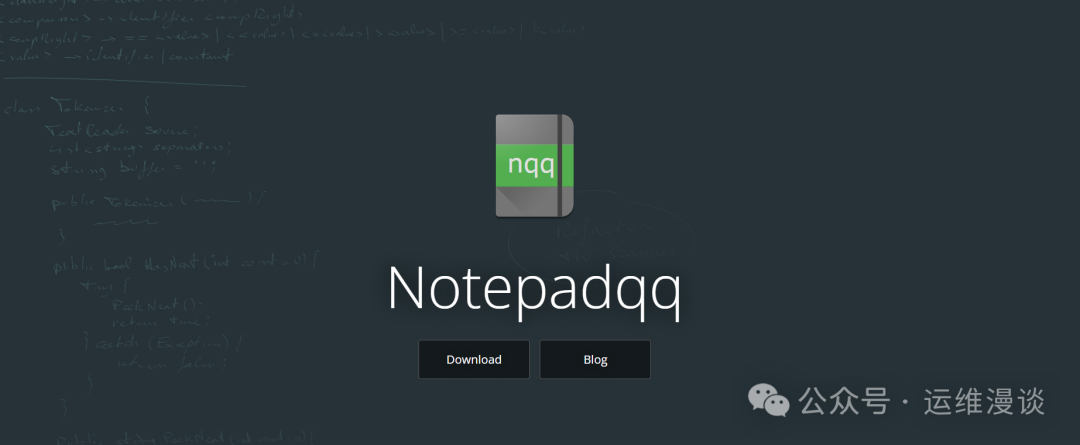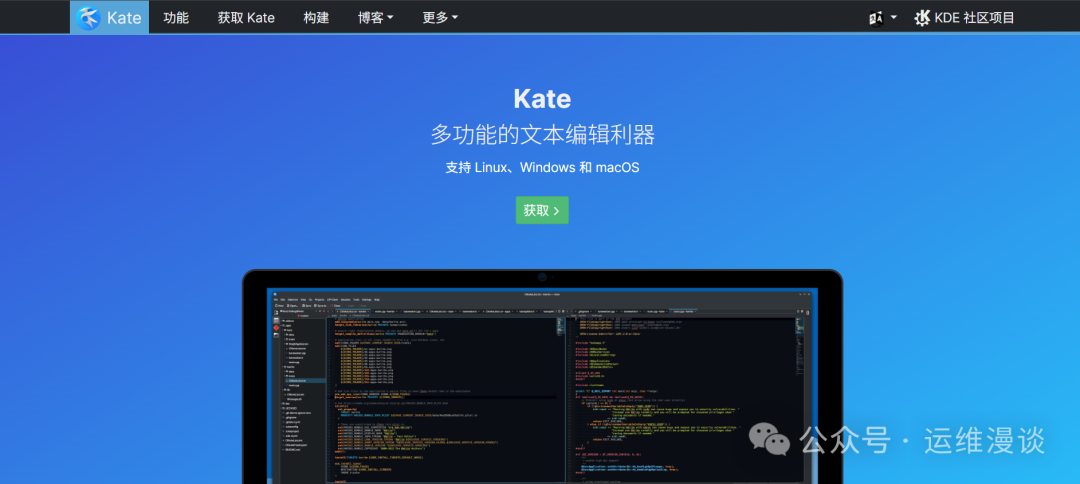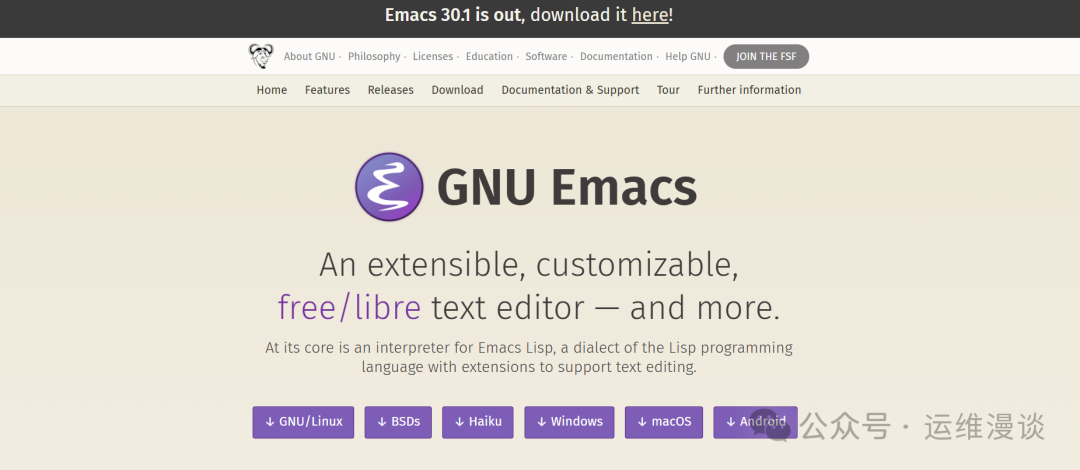Notepad++ is a widely popular free and open-source code editor on the Windows platform, known for its lightweight, efficient, and feature-rich capabilities (such as syntax highlighting, multi-language support, and plugin extensions), making it a preferred choice for developers. However, since Notepad++ does not provide a native Linux version, Linux users need to look for alternatives with similar functionalities. In 2025, the Linux ecosystem offers numerous powerful text and code editors, ranging from lightweight options to feature-rich IDE alternatives.

1. Visual Studio Code (VS Code)
Visual Studio Code (VS Code), developed by Microsoft, is a free, open-source, cross-platform code editor that has become the top alternative to Notepad++ due to its powerful features and extensive extension ecosystem. It supports almost all programming languages, has built-in Git integration, debugging tools, and intelligent code completion (IntelliSense), making it suitable for a wide range of needs from beginners to professional developers.
https://code.visualstudio.com/

Core Features
- “Syntax Highlighting and Intelligent Completion”: Supports hundreds of languages, with IntelliSense providing context-based code suggestions.
- “Extension Ecosystem”: Install plugins via the Visual Studio Marketplace, supporting extensions for languages like Python, JavaScript, C++, etc.
- “Built-in Git Integration”: Directly perform version control operations such as commits, pushes, and branch management.
- “Debugging Support”: Built-in debugger supporting breakpoints, call stacks, and variable watches.
- “Cross-Platform”: Consistent performance on Linux, Windows, and macOS.
Installation Command (Example for Ubuntu)
# Download and install the .deb package for VS Code
wget -qO- https://packages.microsoft.com/keys/microsoft.asc | gpg --dearmor > packages.microsoft.gpg
sudo install -o root -g root -m 644 packages.microsoft.gpg /etc/apt/trusted.gpg.d/
sudo sh -c 'echo "deb [arch=amd64 signed-by=/etc/apt/trusted.gpg.d/packages.microsoft.gpg] https://packages.microsoft.com/repos/vscode stable main" > /etc/apt/sources.list.d/vscode.list'
sudo apt update
sudo apt install -y code
Usage Examples
- “Open Project Folder”:
code /path/to/project
- “Install Python Extension”:
Press <span>Ctrl+Shift+X</span> to open the extensions panel, search for “Python” and install it.
- “Run Debugging”:
Press <span>F5</span> or go through <span>Run > Start Debugging</span> to start debugging, configuration of <span>launch.json</span> is required beforehand.
Pros and Cons
- “Pros”: Comprehensive features, rich extensions, active community, cross-platform support.
- “Cons”: Based on Electron, higher resource consumption, may not be suitable for low-spec devices.
Use Cases
Suitable for developers needing powerful IDE features, cross-platform development, or team collaboration.
2. Sublime Text
Sublime Text is a lightweight, fast text editor known for its clean interface and high performance. It supports cross-platform use and offers a rich plugin ecosystem, making it a direct competitor to Notepad++. In 2025, Sublime Text 4 remains a popular choice for Linux users.
https://www.sublimetext.com/

Core Features
- “Fast Startup and Response”: Extremely short startup time, suitable for quick edits.
- “Multi-Cursor Editing”: Supports simultaneous editing of multiple lines of code, improving efficiency.
- “Plugin Support”: Install plugins via Package Control, such as Emmet, LSP, etc.
- “Syntax Highlighting”: Supports almost all programming languages.
- “Customizability”: Customize shortcuts, themes, and settings via JSON files.
Installation Command (Example for Ubuntu)
# Add Sublime Text repository and install
wget -qO - https://download.sublimetext.com/sublimehq-pub.gpg | sudo apt-key add -
echo "deb https://download.sublimetext.com/ apt/stable/" | sudo tee /etc/apt/sources.list.d/sublime-text.list
sudo apt update
sudo apt install -y sublime-text
Usage Examples
- “Open File”:
subl /path/to/file
- “Install Package Control”:
Press `Ctrl+“ to open the console, paste the following code and hit enter:
import urllib.request,os; pf = 'Package Control.sublime-package'; ipp = sublime.installed_packages_path(); urllib.request.install_opener( urllib.request.build_opener( urllib.request.ProxyHandler()) ); open(os.path.join(ipp, pf), 'wb').write(urllib.request.urlopen( 'https://packagecontrol.io/' + pf.replace(' ','%20')).read())
- “Multi-Cursor Editing”:
Press <span>Ctrl</span> and click multiple times on different lines, or use <span>Ctrl+Shift+L</span> to select multiple lines.
Pros and Cons
- “Pros”: Lightweight, fast, aesthetically pleasing interface, rich plugins.
- “Cons”: Free version has a paywall prompt, some advanced features require a license.
Use Cases
Suitable for developers who prioritize speed and simplicity, especially in front-end development and scripting.
3. Notepadqq
Notepadqq is a Notepad++ alternative designed specifically for Linux, based on the Scintilla engine, aiming to replicate the functionality and interface of Notepad++. It is lightweight, free, and open-source, making it suitable for users looking for a seamless transition from Notepad++.
https://notepadqq.com/

Core Features
- “Notepad++ Style Interface”: Familiar multi-tab and sidebar design.
- “Syntax Highlighting”: Supports multiple programming languages.
- “Multi-View Editing”: Supports split-screen editing of the same file.
- “Plugin Support”: While not as rich as Notepad++, it supports basic extensions.
Installation Command (Example for Ubuntu)
sudo apt update
sudo apt install -y notepadqq
Usage Examples
- “Open Notepadqq”:
notepadqq
- “Split Screen Editing”:
Select <span>View > Clone to Other View</span> from the menu.
- “Search and Replace”:
Press <span>Ctrl+F</span> to open the find dialog, supporting regular expressions.
Pros and Cons
- “Pros”: Lightweight, familiar interface, easy to use.
- “Cons”: Maintenance has decreased after 2023, with slower feature updates.
Use Cases
Suitable for new Linux users migrating from Notepad++, or developers needing a lightweight editor.
4. Kate
Kate (KDE Advanced Text Editor) is an open-source editor developed by the KDE community, powerful yet lightweight, widely used in Linux desktop environments. It supports a multi-document interface, plugin extensions, and rich programming language support.
https://kate-editor.org/zh-cn/

Core Features
- “Multi-Document Interface”: Supports tabbed and split-window editing.
- “Plugin Ecosystem”: Built-in terminal, GDB debugging, SQL querying, and more plugins.
- “Syntax Highlighting”: Supports over 300 languages.
- “Network Transparency”: Supports editing remote files via FTP, SFTP.
Installation Command (Example for Ubuntu)
sudo apt update
sudo apt install -y kate
Usage Examples
- “Open Kate”:
kate
- “Open Remote File”:
kate sftp://user@host/path/to/file
- “Enable Built-in Terminal”:
Press <span>F7</span> or go through <span>View > Tool Views > Terminal</span> to open.
Pros and Cons
- “Pros”: Lightweight, feature-rich, native Linux experience.
- “Cons”: May depend on more libraries in non-KDE environments.
Use Cases
Suitable for Linux users needing IDE-level features but with lower resource consumption.
5. Geany
Geany is a lightweight IDE and text editor that supports cross-platform use, combining the simplicity of Notepad++ with IDE functionalities. It is known for its fast startup and low resource consumption, making it suitable for small to medium-sized projects.
https://www.geany.org/

Core Features
- “Syntax Highlighting and Completion”: Supports multiple languages, auto-completes tags and keywords.
- “Project Management”: Supports folder-level project organization.
- “Built-in Terminal”: Directly run compile or script commands.
- “Plugin Support”: Extend functionality with features like file browser, version control, etc.
Installation Command (Example for Ubuntu)
sudo apt update
sudo apt install -y geany geany-plugins
Usage Examples
- “Open Geany”:
geany
- “Compile Code”: Press
<span>F8</span>or go through<span>Build > Compile</span>to compile the current file. - “Run Program”: Press
<span>F5</span>or go through<span>Build > Execute</span>to run.
Pros and Cons
- “Pros”: Lightweight, fast, balanced functionality.
- “Cons”: Interface is somewhat plain, plugin ecosystem is not as rich as VS Code.
Use Cases
Suitable for lightweight programming and quick editing, especially on resource-limited devices.
6. Vim
Vim (Vi IMproved) is the most well-known terminal text editor in the Linux ecosystem, renowned for its efficiency and customizability. Although the learning curve is steep, its powerful command mode makes it a preferred choice for professional developers.
Core Features
- “Multi-Mode Editing”: Normal mode, insert mode, command mode.
- “Plugin Support”: Install plugins via managers like Vim-plug.
- “Syntax Highlighting”: Supports multiple languages.
- “Macros and Scripts”: Record and replay complex operations.
Installation Command (Example for Ubuntu)
sudo apt update
sudo apt install -y vim
Usage Examples
- “Open File”:
vim /path/to/file
- “Install Vim-plug”:
curl -fLo ~/.vim/autoload/plug.vim --create-dirs \
https://raw.githubusercontent.com/junegunn/vim-plug/master/plug.vim
Add the following to <span>~/.vimrc</span>:
call plug#begin()
Plug 'scrooloose/nerdtree'
call plug#end()
Then run <span>:PlugInstall</span>.
- “Quick Navigation”:
- Jump to the end of the file:
<span>G</span> - Find string:
<span>/pattern</span>
Pros and Cons
- “Pros”: Extremely efficient, very low resource consumption, cross-platform.
- “Cons”: Steep learning curve, difficult for beginners to pick up.
Use Cases
Suitable for advanced users familiar with terminal operations, seeking keyboard efficiency.
7. Emacs
Emacs is a highly customizable open-source editor with over 40 years of history. It is not just a text editor but can be extended into an IDE, email client, or even a gaming platform through plugins.
https://www.gnu.org/software/emacs/

Core Features
- “Highly Customizable”: Customize functionalities through Emacs Lisp scripts.
- “Plugin Ecosystem”: Supports powerful extensions like LSP, Org-mode, etc.
- “Multi-Language Support”: Built-in syntax highlighting and completion.
- “Cross-Platform”: Runs on Linux, Windows, and macOS.
Installation Command (Example for Ubuntu)
sudo apt update
sudo apt install -y emacs
Usage Examples
- “Open Emacs”:
emacs
- “Install Spacemacs (Modern Configuration)”:
git clone https://github.com/syl20bnr/spacemacs ~/.emacs.d
- “Quick Navigation”:
- Jump to line:
<span>M-g g</span> - Find file:
<span>C-x C-f</span>
Pros and Cons
- “Pros”: Extremely powerful, highly customizable.
- “Cons”: Higher resource consumption, steep learning curve.
Use Cases
Suitable for advanced users needing an all-in-one tool or developers willing to invest in a learning curve.
8. GNOME Text Editor
GNOME Text Editor is the default text editor for the GNOME desktop environment, built on GTK4 and libadwaita, focusing on a clean and modern user experience. While it may not be as comprehensive as Notepad++, it is suitable for basic code and text editing.
Core Features
- “Modern Interface”: Supports automatic switching between light/dark themes.
- “Syntax Highlighting”: Supports common programming languages.
- “Regular Expression Search”: Powerful find and replace functionality.
- “Auto Save”: Supports recovery of unsaved files.
Installation Command (Example for Ubuntu)
sudo apt update
sudo apt install -y gnome-text-editor
Usage Examples
- “Open Editor”:
gnome-text-editor
- “Open File”:
gnome-text-editor /path/to/file
- “Regular Expression Search”: Press
<span>Ctrl+F</span>, enable the regular expression option.
Pros and Cons
- “Pros”: Lightweight, modern interface, integrated with GNOME environment.
- “Cons”: Basic functionality, limited plugin support.
Use Cases
Suitable for GNOME users or beginners needing a simple editor.
Comparison
| Editor | Lightweight | Plugin Support | Learning Curve | Cross-Platform | Use Cases |
|---|---|---|---|---|---|
| VS Code | Medium | Rich | Medium | Yes | All-purpose development, team collaboration |
| Sublime Text | Lightweight | Rich | Low | Yes | Quick editing, front-end development |
| Notepadqq | Lightweight | Limited | Low | No | Notepad++ migrating users |
| Kate | Lightweight | Rich | Low | Yes | KDE users, small to medium projects |
| Geany | Lightweight | Medium | Low | Yes | Lightweight IDE, quick development |
| Vim | Extremely Lightweight | Rich | High | Yes | Terminal users, efficient editing |
| Emacs | Medium | Rich | High | Yes | All-in-one tool, advanced users |
| GNOME Text Editor | Lightweight | Limited | Low | No | Simple editing, GNOME users |
Selection Recommendations
- “Beginners or Notepad++ Migrating Users”: Recommended Notepadqq or Sublime Text, familiar interface and easy to use.
- “Need IDE Features”: VS Code or Kate provide powerful features suitable for complex projects.
- “Terminal Enthusiasts”: Vim or Emacs are efficient choices but require time investment to learn.
- “Lightweight Needs”: Geany or GNOME Text Editor are suitable for resource-limited devices.

Important! Operations and Maintenance Discussion Group Open for External Access!Scan to add the editor’s WeChat,apply to jointhe group ▲ Long press to join the group
▲ Long press to join the group